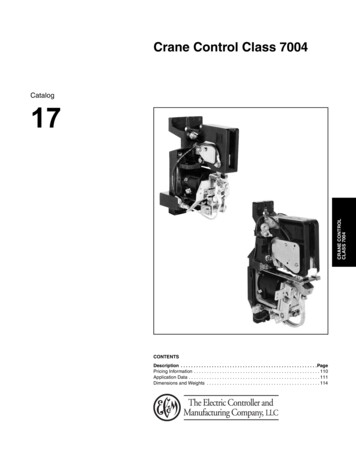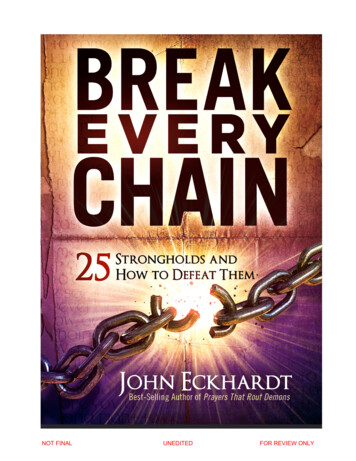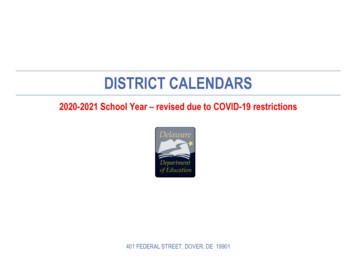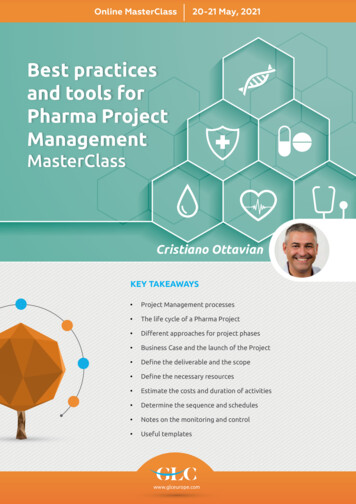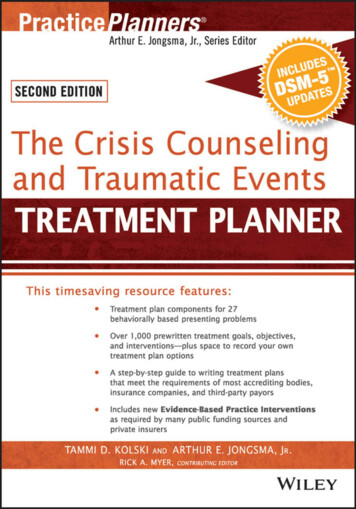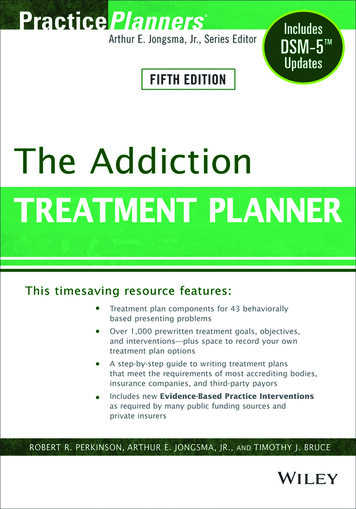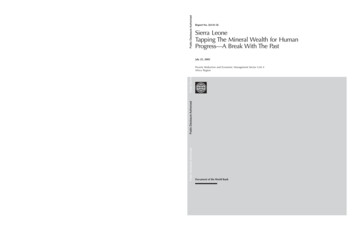
Transcription
Public Disclosure AuthorizedPublic Disclosure AuthorizedSierra LeoneTapping The Mineral Wealth for HumanProgress A Break With The PastJuly 25, 2005Poverty Reduction and Economic Management Sector Unit 4Africa RegionTapping The Mineral Wealth for Human Progress A Break With The PastPublic Disclosure AuthorizedSierra LeonePublic Disclosure AuthorizedReport No. 26141-SLReport No. 26141-SLDocument of the World Bank
Table of Contents. i.EXECUTIVE SUMMARY .I. STATUS OF THE MINING SECTOR .1A.INTRODUCTION. 1B.SIGNIFICANCE. 2PREFACE111.CDEFGHI. 3. 5CURRENT INSTITUTIONAL, REGULATORY AND FISCALFRAMEWORKS. 7ASSESSMENTOF PERFORMANCE.9INCOME GENERATIONIN ARTISANALDIAMONDMININGAND TRADING.11ENVIRONMENTAL,HEALTH AND SOCIAL IMPACTS .16POTENTIAL.17MINERALENDOWMENTSECTOR STRUCTUREROLE OF THE MINING SECTOR IN POST-WAR RECOVERYI1AB.c.DEFG.VISION AND POLICY OB F,C IVESDEVELOPMENTOF AN INTEGRATED NATIONALMINERALPOLICYFRAMEWORKMACROECONOMICAND TRADEPOLICIESFISCALFRAMEWORKLEGALAND REGULATORY FRAMEWORKINSTITUTIONAL FRAMEWORKAND ADMINISTRATIVE CAPACITYENVIRONMENTALAND SOCIAL MANAGEMENTI11 RECOMMENDATIONS AND ACTION PLANS FOR ACHIEVING SECTORGOALS.AB.LARGE-SCALE MININGSUB-SECTORARTISANALAND SMALL-SCALE MININGSUB-SECTOR1919202122232429323233
TablesTable 1:Table 2:Table 3:Key Mining Sector Indicators .Registered Mineral Exports .RegisteredMineral Exports .223Table 4:License Fees for Diamond Dealers and Exporters .9Table 5:Estimates o f Artisanal Diamond Miners and their Dependents.11Table 6:Table 7:. Table 8:Table 9 :Table 10:Breakdown o f Diamond Costs and Revenues between Principal Stakeholder Groups .12Sierra Leone Mining Potential . 18Sierra Leone Time Frame and Actions for Mining Sector Revival and Development .36Fees to be Paid Prior to Award o f an Artisan Diamond MiningLicense .Fee Structure for Diamond Dealers and their Agents .3738Table 11:Fee Structure for Diamond Exporters and their Agents., .38Table 12:Official Exports o f Diamonds from Sierra Leone, 1999-2001.40Table 13:Monthly Diamond Exports under the Terms o f the Certificate o f Origin Scheme .41Table 14:Destination o f Diamond Shipments under the Certificate o f Origin Scheme .41Annexes. 3 8. 40. 44. 47. 48. S O.52References . 59Annex 1:Annex 2:Annex 3:Annex 4:Annex 5:Annex 6:Annex 7:Artisanal. Small.Scale. Dealer and Export License RegulationsThe Certificate o f Origin Scheme for rough diamond exportsA l l u v i a l Diamond Mining IndustryDiamond ExportsReward Share in Alluvial Diamond MiningThe M i n e s and Minerals A c tMining Sector Workshop - Summary o f Findings and RecommendationsThis report was prepared by a team led in 2002 by Preeti Arora (AFTP4) which included LeoMaraboli (COCPD). Jack Gamett (consultant .legal and regulatory issues). and DonaldSutherland (consultant .artisanal diamonds) . The team worked closely with the GovernmentTask Force o n the Mining Sector. jointly chaired by Mr. A . C. Wurie (Director. GeologicalSurvey) and Mr. A . Wurie (Director. Mines Department) and wishes t o thank a l l members o fthe Task Force f o r their support and active participation . The quality assurance teamcomprised Emmanuel Akpa (Sector Manager). Peter van der Veen and Paulo de Sa (PeerReviewers).
TAPPINGTHE MINERAL WEALTH FOR HUMANPROGRESSA BREAKWITH THE PASTPREFACET h e original version o f this report was issued in December 2002. A new edition o f the reporthas been reissued in light o f strong continued interest in the minerals and metals sector inSierra Leone and continued progress by Government in sector reforms.The study, undertaken jointly by the Government o f Sierra Leone and W o r l d Bank staff,provides an assessment and analysis o f the economic and social importance o f the miningsector and i t s impact o n economic outcomes. It makes recommendations and identifies anaction plan for mining sector revival and development. Relevant international agencies,associations and organizations participant to mineral sector initiatives, and representatives o fUSAID and DFID have been consulted. T h e Government presented this report to thestakeholders, including i t s international development partners, at a workshop in M a y 2003.The outcome o f the discussions and recommendations i s reflected in the report. The resultingreport was subsequently discussed in a second national workshop during January 2004.At the time this report was written in late 2002, the Government intended to create a nationalpolicy framework for sustainable development o f the mineral sector. The Government hasbegun that work and has identified the following priorities and challenges:stimulate investment in the sector by establishing an enabling environment whichpromotes private participation;ensure that mineral wealth supports sustainable economic and social development o f thecommunities, and specially improve the living conditions o f artisanal miners and theirdependents;regularize and improve artisanal mining through security o f tenure for licenses and leases;minimize and mitigate the adverse social and environmental impacts o f existing mineralactivities and further mineral development;encourage and promote technology transfer; and harmonize policy with those o fcompeting and neighboring countries to discourage smuggling and encourage tradingthrough official channels.The Government has made progress towards these goals. Since January 2003, the Ministry o fMineral Resources has focused o n a number o f fronts including:o000formation o f a core mineral policy, informed in part by the findings o f the original versionof this report, approved by Cabinet in late 2003;deepening the policy work through a review o f the mineral and regulatory frameworkwith assistance from DFID;efforts to improve the development o f basic mapping geo-information in collaborationwith U N D P and private firms;completion o f the initial work required for the improved administration and managementof mineral rights through a cadastre system based o n a computerized geographicinformation system with data from global positioning satellites. The initial application o fthis system would be in the Kono area, to be subsequently expanded nation wide. This
000work was initiated under the World Bank's Third Economic Rehabilitation and Recoverycredit (ERRC 111) in collaboration with DFID and UNDP and i s being continued underthe Fourth Economic Rehabilitation and Recovery grant (ERRG IV);improvements in productivity, safety and environmental conditions o f mining activitiesthrough the expanded provision o f mining sector extension services. This work was alsoinitiated under the ERRC I11and i s being continued under ERRG IV;increased transparency in mineral sector revenues through the Extractive IndustriesTransparency Initiative (EITI) and Kimberley Process; andimproved social conditions in the mining areas through a variety o f means including theencouragement o f cooperatives, capacity building and training, including initiatives suchas the Peace Diamonds Alliance.These efforts have led to positive results. Among the most notable i s the sharp rise indiamond exports at 691,757 carats in 2004 (37 percent larger than exports o f 2003 at 506,723carats), with a mechanized kimberlite project already started and showing progress, while asecond kimberlite based operation i s expected to start soon. Additionally, the rehabilitationo f a rutile mine was initiated in M a y 2005; the possible reactivation o f the existing bauxitemine during 2005 i s being currently assessed; and a significant increase in mineralexploration i s being noted throughout the country.11
EXECUTIVE SUMMARYA.BACKGROUND1.Sierra Leone i s gradually remaking i t s e l f into a stable and growing nation, and in sodoing, i t i s making a visible break with i t s troubled past. After independence in 1961, SierraLeone suffered from major ethnic strife, civil war, institutional instability and poorgovernance. An initial annual growth o f four percent after independence was followed byacute deterioration o f economic and social conditions since the 1970s. This was largely theresult o f inappropriate government policies and poor governance. Political instability andlack o f an enabling and internationally competitive environment conducive to attractinginvestments particularly affected the mining sector. Excessive government control andattempts to raise higher foreign exchange and fiscal revenues from artisanal diamondactivities were detrimental to artisanal mining development.2.The c i v i l war which ended in January 2002 had particularly profound negativeimpacts o n agricultural and mining activities. Real GDP declined at annual rates above 6percent during 1995-2000. Mechanized mining, excluding small-scale diamond mining cameto a standstill, with the large-scale rutile and bauxite mines closed since the rebel attacks nearthe mines in early 1995. Production dived during the conflict, and most output from artisanalmining flowed into unofficial marketing channels. Sierra Leone emerged from the civil warwith i t s large-scale mining sector closed down, and with small-scale alluvial mining at muchlower levels o f production than during pre-war period.3.With the conflict over, there i s an opportunity and a need for realizing the potential o fthe sector to contribute to growth and development. Quick reactivation o f closed minesfollowed by new investments in large-scale mining can provide much needed governmentrevenues and foreign exchange earnings to support the reconstruction efforts o f thegovernment. Improved conditions for artisanal mining will lead to higher incomes and abetter quality o f l i f e for rural areas dependent o n mining activities. Revival o f the miningsector i s a key component o f the Government’s post-conflict growth and developmentstrategy as l a i d out in i t s I-PRSP. The Government has initiated policies and programs aimedat achieving these broad objectives. These include the preparation o f amendments to the1996 Minerals Act; and strategies to regulate and administer artisanal and small-scalediamond mining to increase benefits to miners, local communities and the economy.However, the design and implementation o f programs for mineral sector development i scomplex, and given the past history o f poor governance, it will be a very challenging task inpost-conflict Sierra Leone. Additionally, the formulation o f such programs i s made moredifficult by the weakness o f the underlying database on both the potential and impacts. T h i sreport attempts to use existing experience o f international best practice and the fragmenteddatabase to provide a knowledge base that could guide future development o f the sector.B.THEMININGSECTOR4.Sierra Leone i s well endowed with mineral resources and produced diamonds, rutile,bauxite and gold until the conflict. I t s rutile deposits are world class and Sierra Leone hadbeen a major source o f high quality rutile for the global market. Other identified mineralsinclude iron ore, platinum, chromite, lignite, clays, and base metals (copper, nickel,molybdenum, lead and zinc). Sierra Leone’s dependence o n the mining sector i s reflected byi t s high contribution to GDP (20 %) and registered exports (90%) throughout most o f the.111
1990s. Fiscal revenues peaked at about 8 percent o f GDP in 1990 and declined steadily toless than 2 percent after the closure o f the two large-scale mines in 1995. During the 199Os,mining and quarrying provided livelihood for over 250,000 people, and employed about 14percent o f the total labor force, directly or indirectly.5.By international standards, the size o f the mining sector in Sierra Leone i s modest.Further, i t s structure i s complex relative to that o f some other countries with successfulmining sectors. The latter are typically characterized by large mining sectors focused o n asingle commodity and comparatively larger mines. Therefore, the experiences and lessonslearned from the development o f their mining sectors need to be adjusted and adapted to theparticular conditions prevailing in Sierra Leone.6.The mineral sector in Sierra Leone i s made up o f three sub-sectors: a) large-scaleproduction o f non-precious minerals - rutile and bauxite; b) large-scale production o fprecious minerals - diamonds; and c) artisanal and small-scale production o f preciousminerals - mainly diamonds, and to a much lesser extent gold. Large-scale miningoperations in the non-precious minerals sub-sector were foreign owned and included SierraLeone Ore and Metal Company (SIEROMCO) for bauxite and Sierra Rutile Limited (SRL)for titanium minerals. Large-scale production o f diamonds was fully state owned from 1984onwards. Following severe deterioration in i t s performance leading to a steep decline inproduction by 1992, the Government initiated the liquidation o f the National DiamondMining Company (NDMC)'. Rudimentary artisanal mining continues to be fully private,with a few mid-size companies, and with foreigners and resident Lebanese and Gambianshaving key roles, particularly in financing and marketing. Additionally, an extensive butlittle known medium-scale mechanized diamonds sub-sector appears to be emerging alongthe borders with Liberia and Guinea.7.Formal diamond production has declined steadily since the early 1980s. Attempts toforce the trade o f alluvial diamonds into official channels were unsuccessful, and efforts totighten controls and enforce foreign exchange surrender requirements resulted in increasedsmuggling. Nevertheless, partner country trade data indicates that the overall volume (legaland illegal) o f diamond exports appeared to remain stable, as the declining output o f the stateowned company was largely compensated with production from artisanal miners exportedthrough illegal channels. As a consequence o f this switch from formal to informal channels,fiscal revenues from this sub-sector became insignificant.8.Other minerals experienced fluctuating earnings due to instability in internationalmineral prices. Rutile experienced sharp growth during 1980s and early 1990s, but furtherincrease in production required new investments, which were being formulated when theattacks o n the mine forced i t s closure. As to bauxite, production also increased substantiallyduring the 1980s, as a result o f high demand that was met by significant investments duringthe first h a l f o f the decade. Output later declined, as investments leveled o f f with demand.9.Sierra Leone has good potential for additional discoveries o f mineral deposits. Thegeneral geology suggests that (i)endowments exceed what i s known and i s being worked;under the right conditions, new exploration and development would open new mines.and (ii)Within a decade, the successful realization o f the large-scale mineral potential o f the country- in diamonds, gold, r u t i l e and bauxite - can result in the establishment o f four new mines inaddition to the reactivation o f the existing three mines. As a result, total annual mineralexport revenues could easily top US 370 million. Direct and indirect employment in these' Most o f the assets o f NDMC were sold by 1994, but it remains as a dormant company in the public portfolioiv
mines could amount to about 38,000 people. An estimated 300,000 people (includingdependents and extended families) could derive their livelihood from these mines.Additionally, with an improvement in the environment for artisanal mining, alluvial diamondand gold production could increase due to higher resource recovery and processingefficiency. An improved governance framework could increase the flow o f these mineralsthrough the official channels.C.SECTOR GOALS AND POLICY OBJECTIVES10.The Government’s goals for large-scale mining are to increase output, employment,reactivating existing rutile, bauxite andfiscal revenues and foreign exchange through: (i)diamonds mines; (ii)promoting the development o f an existing pipeline o f identifiedpromoting exploration o f favorable geological target areas topromising deposits; and (iii)ensure developing and maintaining an adequate pipeline o f promising prospects that can beproposed to potential investors.In the considerably more extensive small-scale and artisanal mining sub-sectors, the11.Government’s goal i s to improve the overall standard o f living o f the involved communities,through: (i)modernizing the licensing o f all mineral rights using a first-come-first-serveapproach with rapid and transparent processing - incorporating an integrated cadastralsystem, supported by satisfactory monitoring, administration and enforcement o f rights; (ii)facilitating mechanization through the establishment o f a credit or revolving fund scheme toenable the purchase, rent or lease o f equipment, which in turn would reduce the dependenceo f miners o n existing financing arrangements that have often resulted in patronization andproviding extension services to assist miners in selecting best areas tocontinued poverty; (iii)mine in their mineral concession areas, planning mining activities, processing the oresadequately, ensuring sound environmental and safety conditions, and administeringexcavating work with adequate mechanisms to identify diggers with license holders throughtagging arrangements; and (iv) providing a level playing field for the license holders as wellas diggers through training to enhance their product evaluating capabilities.The Government envisions that successful mineral development will be led by the12.private sector and will require continued peace and stability; stable macroeconomicenvironment; predictable and transparent legal and fiscal frameworks to attract foreign andlocal investment in exploration and mineral development; and strengthened capacity o f theGovernment to provide adequate geological data, and monitor and regulate the sector.Therefore, the Government’s strategy i s to define and enact clear, non-discretionary, andconsistent policies for the sector; to promote private initiatives and investments; to administermineral rights; to gather and provide basic geological information; and to ensure that miningdevelopment i s environmentally and socially sustainable. Other activities o f operational andproductive nature, such as exploration, development, exploitation, beneficiation, smelting andrefining, as well as mining and support services will be left to the private sector.In line with the foregoing, the Govemment plans to develop a national policy13.framework for the mineral sector around the following sectoral goals:stimulate investment in the sector by establishing an enabling environment whichpromotes private participation;(ii) ensure that mineral wealth supports sustainable economic and social developmento f the communities, and specially improve the living conditions o f artisanalminers;(i)V
(iii) regularize and improve artisanal mining through security o f tenure for licenses(iv)(v)(vi)and leases;minimize and mitigate the adverse social and environmental impacts o f existingmineral activities and further mineral development;encourage and promote technology transfer; andharmonize policy with those o f competing and neighboring countries todiscourage smuggling and encourage trading through official channels.DEVELOPMENTOF AN INTEGRATED NATIONALMINERALPOLICY (INMP)FRAMEWORKD.14.The main objective o f the I N M P framework i s to promote the country’s mineralsector as a socially responsible and economically important engine o f growth. DevelopmentFormulation andof an I N M P framework takes time and involves the following steps: (i)approval o f a National Mineral Policy, which i s internationally competitive and sensitive tothe social and environmental impacts o f mining; (ii)Drafting o f mining legislation andregulations based on the policy directives; (iii)Building and/or restructuring linkagesbetween different levels o f government to facilitate the effective administration o f the legalprovisions; (iv) Building capacity - institutional and human; and (v) Establishing liaison andnetworking systems among stakeholders to ensure transparency, effective decision-making,accountability, and facilitation o f smooth sectoral activity.Key factors that determine successful mineral development are: (i)sound15.macroeconomic and trade policies that provide a stable environment, access to foreignexchange, and few restrictions or controls o n mineral exports or needed imports o f plant,machinery, services or related supplies; (ii)a fiscal package that i s equitable for theconcerned stakeholders; (iii)a legal framework, including environmental laws andregulations, that i s transparent and adequately defines the investors rights and obligations;(iv) security o f tenure; and (v) institutional capacity to respond to the needs o f the privateinvestors in an efficient and transparent manner.16.The Government o f Sierra Leone has undertaken significant economic reforms duringmost of the 1989-02 period despite the destabilizing influence o f the c i v i l war. To attractprivate investment in general, and in mining in particular, the Government recognizes thatmaintenance o f macroeconomic stability and creation o f a sound trade environment arecritical, To achieve this, it will have to staunchly implement i t s economic program preparedfor 2002-05. Monetary policy i s aimed at controlling inflation. Foreign exchange auction,introduced in February 2000 has led to a significant reduction in exchange marketsegmentation. However, the process needs to be further strengthened to ensure easy accessand better availability o f foreign exchange. Sierra Leone will also need to complete i t s tradereforms to bring i t s tariff rates in l i n e with those o f i t s neighboring countries.17.As in the case o f many successful mining countries, private investment in mining inSierra Leone can be considerably enhanced by a stable2 and internationally competitive fiscalframework for taxation, royalties, rentals, fees, duties and incentives. Establishing acompetitive fiscal package to induce investments in mineral exploration and minedevelopment will require detailed work that can be executed in t w o phases. In the f i r s t phase,a comparative assessment o f the fiscal regime o f Sierra Leone with those o f other miningcountries such as Ghana, Tanzania, Angola, Peru and Papua New Guinea should be See results in “Mining Sector Reform and Investment, Results o f a Global Survey by The World Bank Groupand Metal Mining Group o f Japan, 200 1.vi
undertaken t o understand and raise stakeholder awareness o n what has worked well and why.This assessment, conducted by the Government with support from international experts, willdetermine areas where Sierra Leone i s non-competitive, and identify options forenhancement. The second phase o f work should involve the detailed modeling andevaluation o f alternative fiscal scenarios and adoption o f the regime that best meets theGovernment’s objectives.18.The legal and regulatory framework o f Sierra Leone needs to compare favorablywith the frameworks o f other mining countries which reformed their mining sectors recently,placing emphasis o n administration, access and transferability o f rights, security o f tenure,operating obligations and rights and penalties. This will require executing comprehensivecomparative reviews o f the existing framework in Sierra Leone with those o f the recentlyreformed mining countries in order to determine specific areas o f disadvantage and optionsfor improvement. The 1996 Minerals A c t offers a good basis in several areas, includingfiscal and environmental considerations as well as certain administration aspects. However,considerable work needs to be done to update and modernize the framework to adapt it to theglobal operating environment in the 21Stcentury. In the case o f Sierra Leone, particularemphasis will need to be given to the incorporation o f cadastral procedures and technologyinto the provision, administration, transfer and enforcement o f mineral rights. T h i s i sparticularly important to enable the regularization and improvement o f transparency in thevast artisanal mining industry. I t i s also important to address legal constraints related to: a)dissemination o f information, including areas available for licensing and status o f minerallicenses issued; b) excessive discretionary power o f authorities; c) strength o f mineral rightsand their possible transfer and mortgage o n commercial basis without specific approvals fromministerial authorities; and d) requirements to proceed from exploration to mining includingconditions o n performance o f obligations, discovery o f an exploitable mineral and technicaland financial capabilities vis-a-vis alternatives based o n the submission o f professionallycredible feasibility studies. Another key area that will require continuing attention, in linewith international practice and trends, concerns the introduction o f measures to ensure thatlocal communities benefit from, and are consulted in a participatory manner about miningoperations both, when advanced exploration i s planned, and when active mining operationshave been approved.19.The institutional capacity o f the Ministry o f Mineral Resources (MMR) needs to bestrengthened. I t needs to be restructured and reorganized to administer more effectively andefficiently a new private sector oriented Mineral Policy and i t s inter-ministerial imperatives.The reactivation o f existing mines, improvement o f artisanal mining, and initiation o fmeaningful activities for mineral sector development will require the adoption o f a phasedapproach to restructure MMR. This i s warranted by the existing scarcity o f materialresources, and need to avoid over-extending i t s present weak setup. Initial emphasis shouldbe o n establishing a Mining Investment Policy and Planning Department, and a MineralLicense Application and Registry Office with clearly defined mandates and roles.Subsequent emphasis should be o n strengthening the structure o f the Geological SurveyDepartment (GSD), and the Inspectorate, Monitoring and Extension Services. These effortsshould proceed in parallel from the outset with comprehensive capacity building. In the shortterm, this phased approach will expedite the adoption o f both a cadastral system for matterso n mineral rights and a “one-stop-shop” for investment promotional initiatives and interI t will also make possible the compilation o f geo-databases withagency linkages.information presently available at GSD, and the initiation o f pilot extension services withexisting field staff. Additionally, it will allow incorporating the results o f such pilots in theformulation o f improved structures for GSD, and for the Inspectorate, Monitoring andvii
Extension Services. Capacity building, in the short term, would largely involve pa
TAPPING THE MINERAL WEALTH FOR HUMAN PROGRESS A BREAK WITH THE PAST PREFACE The original version of this report was issued in December 2002. A new edition of the report has been reissued in light of strong continued interest in the minerals and metals sector in Sierra Leone and continued progress by Government in sector reforms. The study, undertaken jointly by the Government of Sierra Leone .


